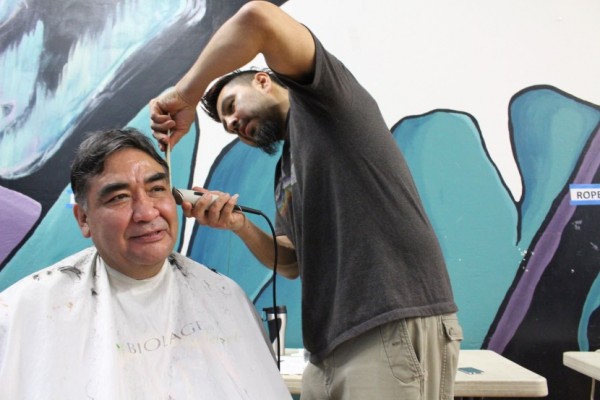Alaska now has a more localized way of looking at homelessness data. Instead of gathering information that reflects the state as a whole, some municipalities can see their own data that gets reported to the feds. That could mean more funding for housing in some communities.

At Juneau’s Project Homeless Connect event, people were getting help in a number of ways.
John Ross hasn’t had a haircut in a while. His hair is black with wisps of gray feathering from the temples. He says he wants something polished — just nothing high and tight.
“I was in the service, I’ve had everything cut off. I don’t want that again,” Ross said.
He’s waiting with three other people at the Zach Gordon Youth Center. A salon called Shear Design is volunteering staff for the day, and so far, they’ve been busy nonstop giving people cuts.
Ross has been sleeping at the Glory Hole on-and-off for about four years. In the summer, he works at Taku Smokeries.
“Soon as they open up the campground, I’ll go back there, and I’ll be going back and forth to Taku working and having a place to stay,” he said.
He works the most during salmon season, even doing double shifts. But in the winter, when there’s little seafood coming in, he goes back to being unemployed.
“It’s rough right now so this is really good timing for me. I really do appreciate it. That’s why I like to give something in appreciation of what they’re doing for me.”
He gives away tiny dream catchers, the kind you can hang on a rearview mirror. He made one last year for the woman who cut his hair. At that point, he hadn’t had it cut in seven months.
“And I was really shaggy so I really appreciated it at the time and it’s whole different person who came out of here,” Ross said. “And I was looking for work and a couple of weeks later I did get some work and it’s kind of nice to look good before and when you’re looking, gives you confidence, gives you better chances.”
Just across the parking lot, more than 200 people experiencing homelessness filtered through the Juneau Arts and Culture Center. Booths line the walls of the old gymnasium. You can sign up for Medicaid, have your blood pressure taken, or pick up a pair of socks and gloves.
But first, you have talk to Jackie Triplette, or one of the other volunteers, to take a survey.
“I take you through it question by question. Gender, race, whether it’s an adult or an adult with children,” she said.
There are also some very personal questions on it, like “Have you been a victim of domestic violence or sexual assault?”
“And some people want to talk more and discuss things which is fine,” she said. “It’s nice to meet these people and understand their issues. I think more people would understand what’s happening to these people if they came and volunteered to do this.”
This is Triplette’s second year volunteering to do this. Project Homeless Connect has been going on for five. Triplette says when people sit down with her, she tries to explain why the survey is important.
“We’re really collecting data so that we know how the community can help our homeless population,” she said.
Every year across the United States, that data gets collected and important policy and funding decisions are made by analyzing it.
“This year we’re working with our administrator to make sure that we break it down by communities,” said Scott Ciambor, the chair of the Alaska Coalition on Housing and Homelessness.
Ciambor says, for many years, the state complied with just the federal requirements. Alaska was broken down into two categories: Anchorage and the rest of the state. Now communities doing the survey can have access to that data, which could help with getting funding for housing — especially permanent supportive housing.
“It’s a game changer,” Ciambor said. “When you’re trying to plan and advocate for resources, the first question is well, what do you have? … So it’s definitely giving communities a tool to address their circumstances for people who are experiencing homelessness.”
John Ross is finishing up his haircut. He’s probably had about an inch cut off. And it looks great. Most of the feathery white has been snipped away.
Before he leaves, he hands the barber a gift — the small dreamcatcher. And heads to the bathroom to check out his new look.
“It’s perfect. The length, everything. I feel better about going, even though I got the job at Taku, it’s still good to look good when you start a job. So I’m happy,” Ross said.
Down the line, he hopes to qualify for other jobs with the vocational training he learned about at today’s event. The results of the survey should be completed sometime in May.




